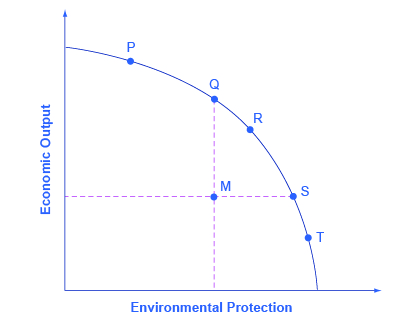| << Chapter < Page | Chapter >> Page > |
By the end of this section, you will be able to:
The tradeoff between economic output and the environment can be analyzed with a production possibility frontier (PPF) such as the one shown in [link] . At one extreme, at a choice like P, a country would be selecting a high level of economic output but very little environmental protection. At the other extreme, at a choice like T, a country would be selecting a high level of environmental protection but little economic output. According to the graph, an increase in environmental protection involves an opportunity cost of less economic output. No matter what their preferences, all societies should wish to avoid choices like M, which are productively inefficient. Efficiency requires that the choice should be on the production possibility frontier.

Economists do not have a great deal to say about the choice between P, Q, R, S and T in [link] , all of which lie along the production possibility frontier. Countries with low per capita gross domestic product (GDP) , such as China, place a greater emphasis on economic output—which in turn helps to produce nutrition, shelter, health, education, and desirable consumer goods. Countries with higher income levels, where a greater share of people have access to the basic necessities of life, may be willing to place a relatively greater emphasis on environmental protection.
However, economists are united in their belief that an inefficient choice such as M is undesirable. Rather than choosing M, a nation could achieve either greater economic output with the same environmental protection, as at point Q, or greater environmental protection with the same level of output, as at point S. The problem with command-and-control environmental laws is that they sometimes involve a choice like M. Market-oriented environmental tools offer a mechanism either for providing either the same environmental protection at lower cost, or providing a greater degree of environmental protection for the same cost.
Depending on their different income levels and political preferences, countries are likely to make different choices about allocative efficiency —that is, the choice between economic output and environmental protection along the production possibility frontier. However, all countries should prefer to make a choice that shows productive efficiency —that is, the choice is somewhere on the production possibility frontier rather than inside it. Revisit Choice in a World of Scarcity for more on these terms.
In the Land of Purity, there is only one form of pollution, called “gunk.” [link] shows possible combinations of economic output and reduction of gunk, depending on what kinds of environmental regulations are chosen.
| Combos | Eco Output | Gunk Cleaned Up |
|---|---|---|
| J | 800 | 10% |
| K | 500 | 30% |
| L | 600 | 40% |
| M | 400 | 40% |
| N | 100 | 90% |

Notification Switch
Would you like to follow the 'Openstax microeconomics in ten weeks' conversation and receive update notifications?